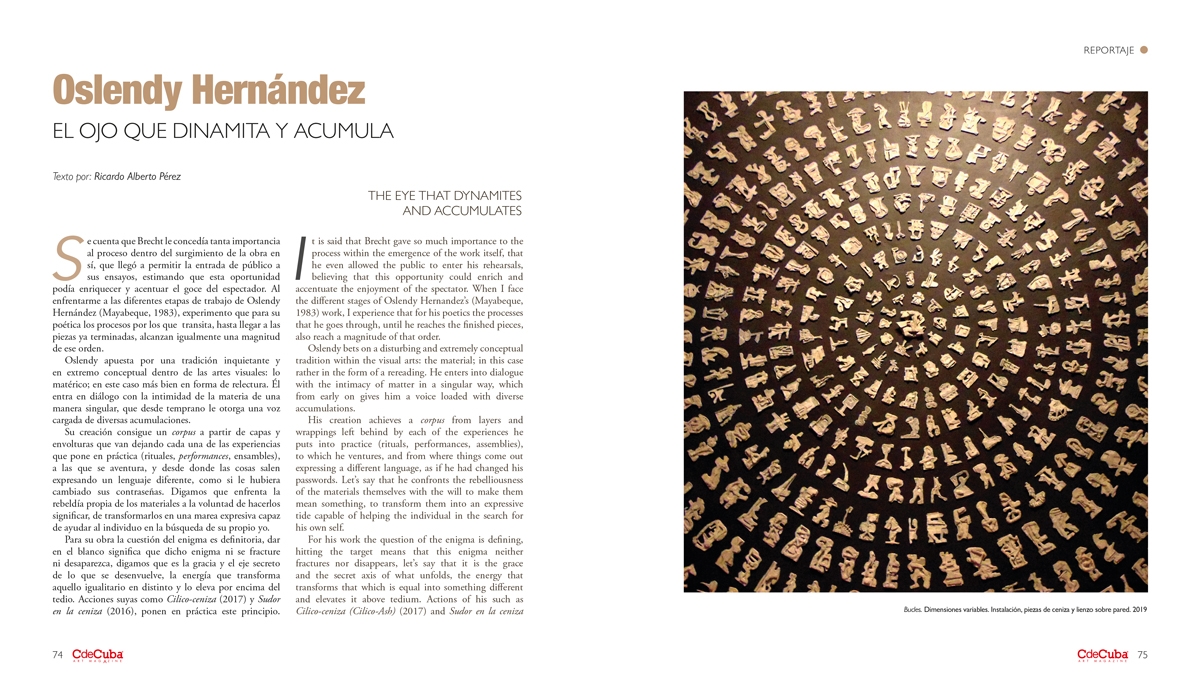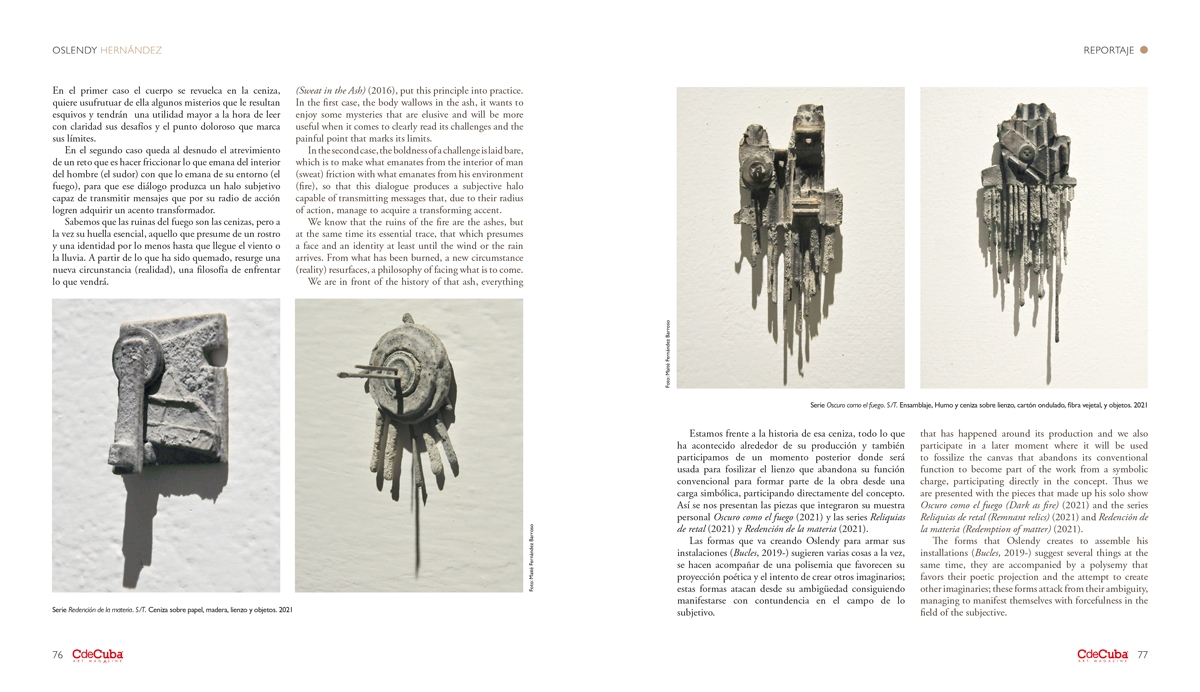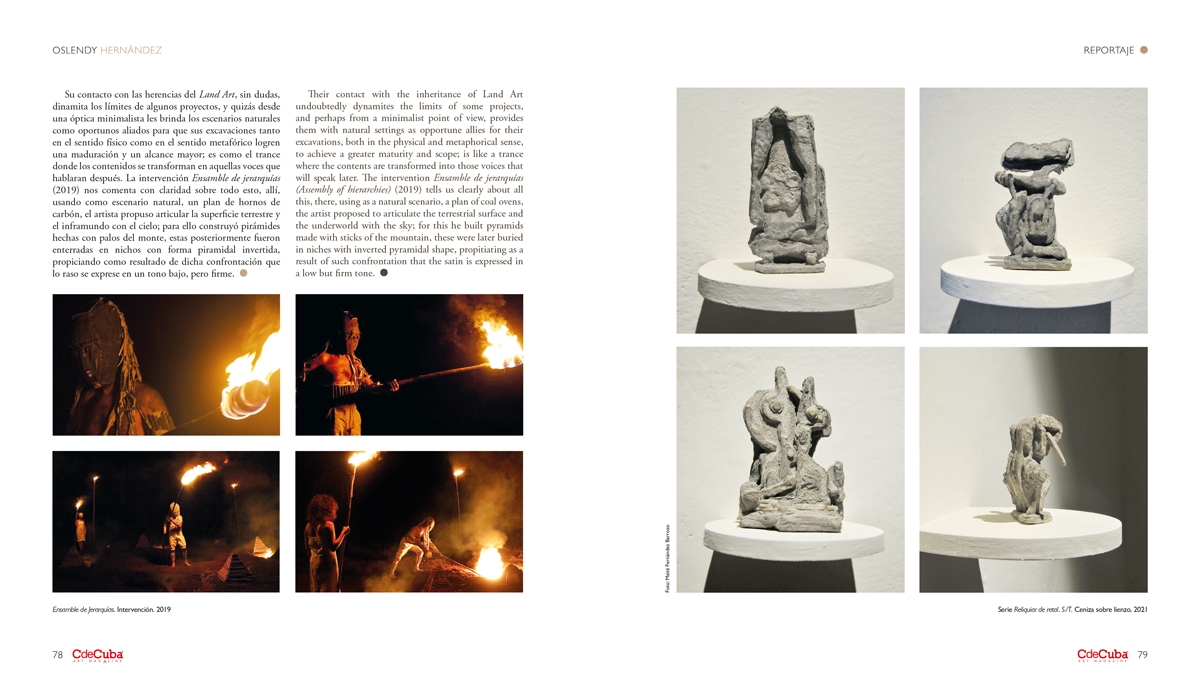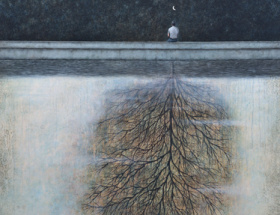The Eye That Dynamites and Accumulates
By Ricardo Alberto Perez
The willingness to look inside things makes the sight become sharp,
the sight becomes penetrating. It makes vision a violence, it finds the fracture, the crack,
the interstice through which the secret of hidden things can be violated…
Gaston Bachelard
It is said that Brecht gave so much importance to the process within the emergence of the work itself, that he even allowed the public to enter his rehearsals, believing that this opportunity could enrich and accentuate the enjoyment of the spectator. When I face the different stages of Oslendy Hernandez’s (Mayabeque, 1983) work, I experience that for his poetics the processes that he goes through, until he reaches the finished pieces, also reach a magnitude of that order.
Oslendy bets on a disturbing and extremely conceptual tradition within the visual arts: the material; in this case rather in the form of a rereading. He enters into dialogue with the intimacy of matter in a singular way, which from early on gives him a voice loaded with diverse accumulations.
His creation achieves a corpus from layers and wrappings left behind by each of the experiences he puts into practice (rituals, performances, assemblies), to which he ventures, and from where things come out expressing a different language, as if he had changed his passwords. Let’s say that he confronts the rebelliousness of the materials themselves with the will to make them mean something, to transform them into an expressive tide capable of helping the individual in the search for his own self.
For his work the question of the enigma is defining, hitting the target means that this enigma neither fractures nor disappears, let’s say that it is the grace and the secret axis of what unfolds, the energy that transforms that which is equal into something different and elevates it above tedium. Actions of his such as Cilico-ceniza (Cilico-Ash) (2017) and Sudor en la ceniza (Sweat in the Ash) (2016), put this principle into practice. In the first case, the body wallows in the ash, it wants to enjoy some mysteries that are elusive and will be more useful when it comes to clearly read its challenges and the painful point that marks its limits.
In the second case, the boldness of a challenge is laid bare, which is to make what emanates from the interior of man (sweat) friction with what emanates from his environment (fire), so that this dialogue produces a subjective halo capable of transmitting messages that, due to their radius of action, manage to acquire a transforming accent.
We know that the ruins of the fire are the ashes, but at the same time its essential trace, that which presumes a face and an identity at least until the wind or the rain arrives. From what has been burned, a new circumstance (reality) resurfaces, a philosophy of facing what is to come.
We are in front of the history of that ash, everything that has happened around its production and we also participate in a later moment where it will be used to fossilize the canvas that abandons its conventional function to become part of the work from a symbolic charge, participating directly in the concept. Thus we are presented with the pieces that made up his solo show Oscuro como el fuego (Dark as fire) (2021) and the series Reliquias de retal (Remnant relics) (2021) and Redención de la materia (Redemption of matter) (2021).
The forms that Oslendy creates to assemble his installations (Bucles, 2019-) suggest several things at the same time, they are accompanied by a polysemy that favors their poetic projection and the attempt to create other imaginaries; these forms attack from their ambiguity, managing to manifest themselves with forcefulness in the field of the subjective.
Their contact with the inheritance of Land Art undoubtedly dynamites the limits of some projects, and perhaps from a minimalist point of view, provides them with natural settings as opportune allies for their excavations, both in the physical and metaphorical sense, to achieve a greater maturity and scope; is like a trance where the contents are transformed into those voices that will speak later. The intervention Ensamble de jerarquías (Assembly of hierarchies) (2019) tells us clearly about all this, there, using as a natural scenario, a plan of coal ovens, the artist proposed to articulate the terrestrial surface and the underworld with the sky; for this he built pyramids made with sticks of the mountain, these were later buried in niches with inverted pyramidal shape, propitiating as a result of such confrontation that the satin is expressed in a low but firm tone.






